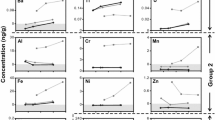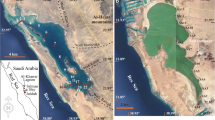Abstract
In order to assess the potential risk of metal release from deep-sea sediments in response to pH decrease in seawater, the mobility of elements from ferromanganese (Fe–Mn) nodules and pelagic clays was examined. Two geochemical reference samples (JMn-1 and JMS-2) were reacted with the pH-controlled artificial seawater (ASW) using a CO2-induced pH regulation system. Our experiments demonstrated that deep-sea sediments have weak buffer capacities by acid–base dissociation of surface hydroxyl groups on metal oxides/oxyhydroxides and silicate minerals. Element concentrations in the ASW were mainly controlled by elemental speciation in the solid phase and sorption–desorption reaction between the charged solid surface and ion species in the ASW. These results indicated that the release of heavy metals such as Mn, Cu, Zn and Cd should be taken into consideration when assessing the influence of ocean acidification on deep-sea environment.


Similar content being viewed by others
References
Awaji S (2009) Elucidation of the distribution and enrichment mechanism of rare metals in deep-sea mineral resources using a simple method for precise simultaneous determination of 61 elements by ICP-MS. Dissertation, the University of Tokyo
Bayon G, German CR, Boella RM, Milton JA, Taylor RN, Nesbitt RW (2002) An improved method for extracting marine sediment fractions and its application to Sr and Nd isotopic analysis. Chem Geol 187:179–199
Boehm HP (1971) Acidic and basic properties of hydroxylated metal oxide surfaces. Discuss Faraday Soc 52:264–275
Byrne RH (2002) Inorganic speciation of dissolved elements in seawater: the influence of pH on concentration ratios. Geochem Trans 2:11–16
Caldeira K, Wickett ME (2003) Oceanography: anthropogenic carbon and ocean pH. Nature 425:365
Caldeira K, Wickett ME (2005) Ocean model predictions of chemistry changes from carbon dioxide emissions to the atmosphere and ocean. J Geophys Res 110:C09S04
Charewicz WA, Zhu C, Chmielewski T (2001) The leaching behavior of ocean polymetallic nodules in chloride solutions. Physicochem Probl Miner Process 35:55–66
De Orte MR, Lombardi AT, Sarmiento AM, Basallote MD, Rodriguez-Romero A, Riba I, Del Valls A (2014) Metal mobility and toxicity to microalgae associated with acidification of sediments: CO2 and acid comparison. Mar Environ Res 96:136–144
Dickson AG (1990) Thermodynamics of the dissociation of boric acid in synthetic seawater from 273.15 to 318.15 K. Deep Sea Res 37:755–766
Dickson AG, Sabine CL, Christian JR (eds) (2007) Guide to best practices for ocean CO2 measurements, vol 3. PICES Special Publication, Sidney, p 191
Endrizzi F, Rao LF (2014) Chemical speciation of uranium(VI) in marine environments: complexation of calcium and magnesium ions with [(UO2)(CO3)3]4− and the effect on the extraction of uranium from seawater. Chemistry 20:14499–14506
European Communities (EC) (1998) Council directive 98/83/EC of 3 November 1998 on the quality of water intended for human consumption. Off J Eur Commun L330:0032–0054. http://ec.europa.eu/environment/water/water-drink/legislation_en.html. Accessed 24 July 2018
Feely RA, Sabine CL, Lee K, Berelson W, Kleypas J, Fabry VJ, Millero FJ (2004) Impact of anthropogenic CO2 on the CaCO3 system in the oceans. Science 305:362–366
Feely RA, Orr J, Fabry VJ, Kleypas JA, Sabine CL, Langdon C (2013) Present and future changes in seawater chemistry due to ocean acidification. In: Mcpherson BJ, Sundquist ET (eds) Carbon sequestration and its role in the global carbon cycle. American Geophysical Union, Washington, pp 175–188
Glasby GP (1991) Mineralogy, geochemistry, and origin of Pacific red clays: a review. NZ J Geol Geophys 34:167–176
Glasby GP (2006) Manganese: predominant role of nodules and crusts. In: Schulz H, Zabel M (eds) Marine geochemistry. Springer, Berlin, pp 371–427
Grotti M, Frachea R (2007) Direct determination of arsenic in sea-water by reaction cell inductively coupled plasma mass spectrometry. J Anal At Spectrom 22:1481–1487
Gupta LP, Kawahata H, Takeuchi M, Ohta H, Ono Y (2005) Temperature and pH dependence of some metals leaching from fly ash of municipal solid waste. Resour Geol 55:357–372
Hauton C et al (2017) Identifying toxic impacts of metals potentially released during deep-sea mining—a synthesis of the challenges to quantifying risk. Front Mar Sci 4:368
Hein JR, Mizell K, Koschinsky A, Conrad TA (2013) Deep-ocean mineral deposits as a source of critical metals for high-and green-technology applications: comparison with land-based resources. Ore Geol Rev 51:1–14
Ilyina T, Zeebe RE (2012) Detection and projection of carbonate dissolution in the water column and deep-sea sediments due to ocean acidification. Geophys Res Lett 39:L06606
International Seabed Authority (2018) Deep seabed minerals contractors. https://www.isa.org.jm/deep-seabed-minerals-contractors. Accessed 24 July 2018
Kanungo SB, Das RP (1988) Extraction of metals from manganese nodules of the Indian Ocean by leaching in aqueous solution of sulphur dioxide. Hydrometallurgy 20:135–146
Kester DR, Duedall IW, Connors DN, Pytkowicz RM (1967) Preparation of artificial seawater. Limnol Oceanogr 12:176–179
Kim HJ, Kim D, Hyeong K, Hwang J, Yoo CM, Ham DJ, Seo I (2013) Evaluation of resuspended sediments to sinking particles by benthic disturbance in the Clarion-Clipperton nodule fields. Mar Georesour Geotechnol 33:160–166
Koschinsky A, Halbach P (1995) Sequential leaching of marine ferromanganese precipitates: genetic implications. Geochim Cosmochim Acta 59:5113–5132
Koschinsky A, Hein JR (2003) Uptake of elements from seawater by ferromanganese crusts: solid-phase associations and seawater speciation. Mar Geol 198:331–351
Leonhard P, Pepelnik R, Prange A, Yamadab N, Yamada T (2002) Analysis of diluted sea-water at the ng L−1 level using an ICP-MS with an octopole reaction cell. J Anal At Spectrom 17:189–196
Li YH (1991) Distribution patterns of the elements in the ocean: a synthesis. Geochim Cosmochim Acta 55:3223–3240
McCurdy E, Woods G (2004) The application of collision/reaction cell inductively coupled plasma mass spectrometry to multi-element analysis in variable sample matrices, using He as a non-reactive cell gas. J Anal At Spectrom 19:607–615
Millero FJ (2013) Chemical oceanography. CRC Press, New York
Millero FJ, Woosley R, Ditrolio B, Waters J (2009) Effect of ocean acidification on the speciation of metals in seawater. Oceanography 22:72
Oebius HU, Becker HJ, Rolinski S, Jankowski JA (2001) Parametrization and evaluation of marine environmental impacts produced by deep-sea manganese nodule mining. Deep Sea Res Part II 48:3453–3467
Parida K, Satapathy PK, Das N (1996) Studies on Indian ocean manganese nodules: IV. Adsorption of some bivalent heavy metal ions onto ferromanganese nodules. J Colloid Interface Sci 181:456–462
Park K (1966) Deep-sea pH. Science 154:1540–1542
Raven J et al (2005) Ocean acidification due to increasing atmospheric carbon dioxide. The Royal Society, London
Roy RN et al (1993) The dissociation constants of carbonic acid in seawater at salinities 5–45 and temperatures 0–45°C. Mar Chem 44:249–267
Schindler PW (1975) Removal of trace metals from the oceans: a zero order model. Thalass Jugosl 11:101–111
Senanayake G (2011) Acid leaching of metals from deep-sea manganese nodules—a critical review of fundamentals and applications. Miner Eng 24:1379–1396
Sharma R (2015) Environmental issues of deep-sea mining. Procedia Earth Planet Sci 11:204–211
Stumm W, Morgan JJ (1996) Aquatic chemistry, 3rd edn. Wiley, New York
Stumm W, Huang CP, Jenkins SR (1970) Specific chemical interaction affecting stability of dispersed systems. Croat Chem Acta 42:223–245
Terashima S, Usui A, Imai N (1995) Two new GSJ geochemical reference samples: syenite Jsy-1 and manganese nodule JMn-1. Geostand Newslett 19:221–229
Terashima S, Imai N, Taniguchi M, Okai T, Nishimura A (2002) The preparation and preliminary characterisation of four New Geological Survey of Japan geochemical reference materials: soils, JSO-1 and JSO-2; and marine sediments, JMS-1 and JMS-2. Geostand Newslett 26:85–94
Tessier A, Campbell PGC, Bisson M (1979) Sequential extraction procedure for the speciation of particulate trace metals. Anal Chem 51:844–851
Thiel H (2001) Evaluation of the environmental consequences of polymetallic nodule mining based on the results of the TUSCH Research Association. Deep Sea Res Part II 48:3433–3452
United States Environmental Protection Agency (USEPA) (2012) Edition of the drinking water standards and health advisories. Washington, DC. https://www.epa.gov/dwstandardsregulations. Accessed 24 July 2018
Verlaan PA, Cronan DS, Morgan CL (2004) A comparative analysis of compositional variations in and between marine ferromanganese nodules and crusts in the South Pacific and their environmental controls. Prog Oceanogr 63:125–158
Wang Q, Kawahata H, Manaka T, Yamaoka K, Suzuki A (2017) Potential influence of ocean acidification on deep-sea Fe–Mn nodules: results from leaching experiments. Aquat Geochem 23:233–246
World Health Organization (WHO) (2011) Guidelines for drinking-water quality, 4th edn. World Health Organization Press. http://www.who.int/water_sanitation_health/publications/2011/dwq_guidelines/en/. Accessed 24 July 2018
Zaman MI, Mustafa S, Khan S, Xing B (2009) Effect of phosphate complexation on Cd2+ sorption by manganese dioxide (β-MnO2). J Colloid Interface Sci 330:9–19
Acknowledgements
We thank the anonymous reviewers for constructive and valuable comments and the editor for the editorial handling of the manuscript. We thank Toshihiro Yoshimura of JAMSTEC (Japan Agency for Marine-Earth Science and Technology) and Yuki Ota of the Atmosphere and Ocean Research Institute, the University of Tokyo for their assistance on ICP-MS measurement. This research was supported by Grants-in-Aids from the Japan Society for the Promotion of Science to H.K. (Nos. 19340146, 22224009 and 15H02139).
Author information
Authors and Affiliations
Contributions
All authors contributed to the design of the experimental strategy. Q.W. and A.S. conducted the experiment and ICP-MS measurements. Q.W. completed the data processing and wrote the manuscript. All authors contributed to revise the manuscript.
Corresponding author
Ethics declarations
Conflict of interest
Competing financial interests: The authors declare no competing financial interests.
Rights and permissions
About this article
Cite this article
Wang, Q., Kawahata, H., Yamaoka, K. et al. Potential Influence of Ocean Acidification on Deep-Sea Fe–Mn Nodules and Pelagic Clays: An Improved Assessment by Using Artificial Seawater. Aquat Geochem 24, 307–322 (2018). https://doi.org/10.1007/s10498-018-9345-y
Received:
Accepted:
Published:
Issue Date:
DOI: https://doi.org/10.1007/s10498-018-9345-y




